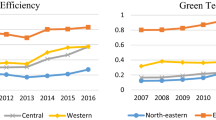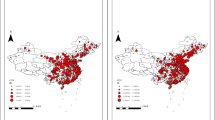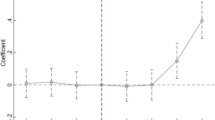Abstract
Green technology innovation shoulders the dual task of green development and innovation leading. It is an inevitable choice for China to achieve the carbon peak and neutrality goal and promote high-quality economic development by effectively stimulating green innovation vitality and improving green innovation capacity. In this context, from the perspective of institutional quality, this study takes the anti-corruption campaign launched since the 18th National Congress of the Chinese Communist Party as a quasi-natural experiment, constructs an intensity difference-in-differences (DID) model, and tests the impact effect and mechanism of the anti-corruption campaign on regional green technology innovation. It is found that the anti-corruption campaign has significantly improved the level of regional green technology innovation. This conclusion still holds after a series of robustness tests such as parallel trend test, placebo test, and instrumental variable estimation. The results of mechanism analysis show that the anti-corruption campaign is helpful to increase foreign direct investment and change the government’s fiscal expenditure bias, thus promoting the improvement of green technology innovation level. Heterogeneity analysis shows that the promotion effect of anti-corruption campaign on green technology innovation is more significant in eastern and southern regions. At the same time, the lower the degree of government intervention, the greater the protection of intellectual property rights, and the stronger the environmental governance, the greater the promoting effect of the anti-corruption campaign on green technology innovation. Further research shows that the improvement of the level of green technology innovation is conducive to the realization of the “dual control” goal of total and intensity of carbon emissions. This study proves the positive externality of anti-corruption campaign from the perspective of green technology innovation and provides new empirical evidence for the advantageous theory of anti-corruption.


Similar content being viewed by others
Data availability
The datasets used and/or analyzed during the current study are available from the corresponding author on reasonable request.
Notes
The eastern regions include Beijing, Tianjin, Hebei, Liaoning, Shanghai, Jiangsu, Zhejiang, Fujian, Shandong, Guangdong, and Hainan; the central and western regions include: Shanxi, Jilin, Heilongjiang, Anhui, Jiangxi, Henan, Hubei, Hunan, Inner Mongolia, Guangxi, Chongqing, Sichuan, Guizhou, Yunnan, Shanxi, Gansu, Qinghai, Ningxia, and Xinjiang. The southern regions include Shanghai, Jiangsu, Zhejiang, Anhui, Fujian, Jiangxi, Hubei, Hunan, Guangdong, Guangxi, Hainan, Chongqing, Sichuan, Guizhou, and Yunnan; the northern regions include Beijing, Tianjin, Hebei, Shanxi, Inner Mongolia, Liaoning, Jilin, Heilongjiang, Shandong, Henan, Shanxi, Gansu, Qinghai, Ningxia, and Xinjiang.
The frequency of terms related to environmental protection is as follows: environmental conservation, environmental protection, pollution, energy consumption, emission reduction, sewage, ecological, green, low-carbon, air, chemical oxygen demand, sulfur dioxide, carbon dioxide, PM10, and PM2.5.
References
Addai B, Tang W, Gyimah AG et al (2022) Income diversification and bank performance nexus: does corruption matter? J Multinatl Financ Manag 65:100757. https://doi.org/10.1016/j.mulfin.2022.100757
Berry H (2017) Managing valuable knowledge in weak IP protection countries. J Int Bus Stud 48:787–807. https://doi.org/10.1057/s41267-017-0072-1
Bi K, Wang Y, Yang C (2014) The impact of innovation resource input on the green innovation capability of green innovation system: an empirical study from the perspective of FDI inflows in manufacturing industry. J China Soft Sci 3:153–166
Bian Y, Wu L, Bai J (2020) Does the competition of fiscal expenditure on science and technology promote the improvement of regional innovation performance? –- a perspective on the flow of R&D factors. J Public Finance 1:45–58. https://doi.org/10.19477/j.cnki.11-1077/f.2020.01.004
Brada JC, Drabek Z, Mendez JA et al (2019) National levels of corruption and foreign direct investment. J Comp Econ 47:31–49. https://doi.org/10.1016/j.jce.2018.10.005
Bwalya SM (2006) Foreign direct investment and technology spillovers: evidence from panel data analysis of manufacturing firms in Zambia. J Dev Econ 81:514–526. https://doi.org/10.1016/j.jdeveco.2005.06.011
Campante FR, Do QA (2014) Isolated capital cities, accountability, and corruption: evidence from US states. Am Econ Rev 104:2456–2481
Chen H, Hao Y, Li J et al (2018) The impact of environmental regulation, shadow economy, and corruption on environmental quality: theory and empirical evidence from China. J Clean Prod 195:200–214. https://doi.org/10.1016/j.jclepro.2018.05.206
Chen S, Chen D (2018) Haze pollution, government governance and high-quality economic development. J Econ Res 2:20–34
Cole MA (2007) Corruption, income and the environment: an empirical analysis. Ecol Econ 62:637–647. https://doi.org/10.1016/j.ecolecon.2006.08.003
Damania R, Fredriksson PG, List JA (2003) Trade liberalization, corruption, and environmental policy formation: theory and evidence. J Environ Econ Manag 46:490–512. https://doi.org/10.1016/S0095-0696(03)00025-1
Deng H, Liu Y (2021) Does anti-corruption affect the regional business environment? Based on the empirical evidence of the anti-corruption campaign since the 18th CPC National Congress. J Econ Sci 4:84–98. https://doi.org/10.12088/PKU.jjkx.2021.04.06
Dong Z, Wang H (2021) Urban wealth and green technology choices. J Econ Res 56:143–159
Duan H, Snyder T, Yuan W (2018) Corruption, economic development, and auto loan delinquency: evidence from China. J Econ Bus 99:28–38. https://doi.org/10.1016/j.jeconbus.2018.08.001
Fan Z (2013) Transfer payments, infrastructure investment and corruption. Comp Econ Soc Syst 2:179–192
Feng S, Zhang R, Li G (2022) Environmental decentralization, digital finance and green technology innovation. Struct Chang Econ Dyn 61:70–83. https://doi.org/10.1016/j.strueco.2022.02.008
Feng Y, Nie C (2022) Re-examining the effect of China’s new-energy demonstration cities construction policy on environmental pollution: a perspective of pollutant emission intensity control. J Environ Plan Manage 65(12):2333–2361. https://doi.org/10.1080/09640568.2022.2050685
Feng Y, Nie C, Zhang D (2021) The influence of broadband infrastructure construction on urban innovation ability. J Stud Sci Sci 39:2089–2100
Gaganis C, Pasiouras F, Voulgari F (2019) Culture, business environment and SMEs’ profitability: evidence from European Countries. Econ Model 78:275–292. https://doi.org/10.1016/j.econmod.2018.09.023
Han B, Xue Q (2008) The impact of host country corruption on FDI and its sources. Contemp Financ Econ 2:99–105
He W, Chen X, Liu ZJ (2022) Can anti-corruption help realize the “strong” Porter hypothesis in China? Evidence from Chinese manufacturing enterprises. J Asian Econ 80(101):473. https://doi.org/10.1016/j.asieco.2022.101473
Hossain AT, Kryzanowski L (2021) Political corruption and corporate social responsibility (CSR). J Behav Exp Financ 31:100538. https://doi.org/10.1016/j.jbef.2021.100538
Huang L, Sun X, Wang X (2019) Anti-corruption and regional entrepreneurship: effects and mechanisms. J Econ Manag 9:5–19
Ji X, Gu N (2021) Will the establishment of intellectual property protection demonstration cities affect the quality of innovation? J Financ Econ 47:49–63. https://doi.org/10.16538/j.cnki.jfe.20210119.304
Kuang H, Akmal Z, Li F (2022) Measuring the effects of green technology innovations and renewable energy investment for reducing carbon emissions in China. Renew Energy 197:1–10. https://doi.org/10.1016/j.renene.2022.06.091
Lee H, Moumbark T (2022) Climate change, corruption, and business bribes in South Asia. Financ Res Lett 102685.https://doi.org/10.1016/j.frl.2022.102685
Li Q, Liu Q, Ma S et al (2019) Loan financing and investment in princeling-backed firms. Pac Basin Financ J 56:71–92. https://doi.org/10.1016/j.pacfin.2019.05.009
Li X (2020) Corruption and economic growth: an empirical analysis based on transnation al panel data. J Xi’an Univ Financ Econ 33:50–60. https://doi.org/10.19331/j.cnki.jxufe.20200106.001
Li X, Luo J, Chan KC (2018) Political uncertainty and the cost of equity capital. Financ Res Lett 26:215–222. https://doi.org/10.1016/j.frl.2018.01.009
Lin B, Ma R (2022a) Green technology innovations, urban innovation environment and CO2 emission reduction in China: fresh evidence from a partially linear functional-coefficient panel model. Technol Forecast Soc Chang 176:121434. https://doi.org/10.1016/j.techfore.2021.121434
Lin B, Ma R (2022b) How does digital finance influence green technology innovation in China? Evidence from the financing constraints perspective. J Environ Manage 320:115833. https://doi.org/10.1016/j.jenvman.2022.115833
Liu B, Lin Y, Chan KC et al (2018) The dark side of rent-seeking: the impact of rent-seeking on earnings management. J Bus Res 91:94–107. https://doi.org/10.1016/j.jbusres.2018.05.037
Liu D, Chen J, Zhang N (2021) Political connections and green technology innovations under an environmental regulation. J Clean Prod 298:126778. https://doi.org/10.1016/j.jclepro.2021.126778
Lu J, Zhang H, Meng B (2021) Corruption, firm productivity, and gains from import liberalization in China. Econ Model 101:105555. https://doi.org/10.1016/j.econmod.2021.105555
Luo Y, Salman M, Lu Z (2021) Heterogeneous impacts of environmental regulations and foreign direct investment on green innovation across different regions in China. Sci Total Environ 759:143744. https://doi.org/10.1016/j.scitotenv.2020.143744
Lv Z, Gao Z (2021) The effect of corruption on environmental performance: does spatial dependence play a role? Econ Syst 45:100773. https://doi.org/10.1016/j.ecosys.2020.100773
Nair M, Arvin MB, Pradhan RP et al (2021) Is higher economic growth possible through better institutional quality and a lower carbon footprint? Evidence from developing countries. Renew Energy 167:132–145. https://doi.org/10.1016/j.renene.2020.11.056
Obobisa ES, Chen H, Mensah IA (2022) The impact of green technological innovation and institutional quality on CO2 emissions in African countries. Technol Forecast Soc Chang 180:121670. https://doi.org/10.1016/j.techfore.2022.121670
Ouyang X, Zhang J, Du G (2022) Environmental regulation and urban green technology innovation: impact mechanism and spatial effect. J Chinese Manag Sci 1-12.https://doi.org/10.16381/j.cnki.issn1003-207x.2022.0642
Pan X, Tian GG (2020) Political connections and corporate investments: evidence from the recent anti-corruption campaign in China. J Bank Finance 119:105108. https://doi.org/10.1016/j.jbankfin.2017.03.005
Qi S, Lin S, Cui J (2018) Can environmental rights trading market induce green innovation? Evidence based on the green patent data of Chinese listed companies. J Econ Res 12:129–143
Qian M, Sun PW, Yu B (2018) Top managerial power and stock price efficiency: evidence from China. Pac Basin Financ J 47:20–38. https://doi.org/10.1016/j.pacfin.2017.11.004
Ren S, Hao Y, Wu H (2021) Government corruption, market segmentation and renewable energy technology innovation: evidence from China. J Environ Manage 300:113686. https://doi.org/10.1016/j.jenvman.2021.113686
Shan S, Genç SY, Kamran HW et al (2021) Role of green technology innovation and renewable energy in carbon neutrality: a sustainable investigation from Turkey. J Environ Manage 294:113004. https://doi.org/10.1016/j.jenvman.2021.113004
Shao X, Zhong Y, Liu W et al (2021) Modeling the effect of green technology innovation and renewable energy on carbon neutrality in N-11 countries? Evidence from advance panel estimations. J Environ Manage 296:113189. https://doi.org/10.1016/j.jenvman.2021.113189
Song D, Li C, Li X (2021) Does the construction of new infrastructure promote the "quality and quantity "of green technology innovation: w\evidence from the National Smart City Pilot. China Popul Resour Environ 31:155–164. https://doi.org/10.12062/cpre.20210411
Sun Y, Chen S (2021) Spatial and temporal evolution pattern and driving factors of green technology innovation efficiency in the Yangtze River Delta Region. J Geographical Res 40:2743–2759. https://doi.org/10.11821/dlyj020210102/
Tan J, Xu X, Xu G (2018) Regional Corruption and corporate operational efficiency: an Empirical test from the perspective of transaction costs. J Modern Financ Econ (journal of Tianjin University of Finance and Economics) 9:18–35. https://doi.org/10.19559/j.cnki.12-1387.2018.09.002
Tao F, Zhao J, Zhou H (2021) Does environmental regulation achieve incremental quality improvement in green technology innovation: evidence from environmental target responsibility system. J Chinese Ind Econ 2:136–154
Tian H, Hao W (2020) FDI, environmental regulation and green innovation efficiency. J China Soft Sci 8:174–183
Tian L, Wang K (2020) Positive externalities of corruption punishment and innovation behavior of enterprises. J Nankai Bus Rev 23:121–131+154
Wang F, Yao S, Qu G (2018) The theoretical mechanism of anti-corruption promoting sustainable and stable economic growth. J Econ Res 1:65–80
Wang J, Zhang Y (2018) Environmental regulation, green technology innovation intention and green technology innovation behavior. J Stud Sci Sci 36:352–360. https://doi.org/10.16192/j.cnki.1003-2053.2018.02.018
Wang M, Li Y, Wang Z et al (2022) Impact of political embeddedness and external financing on the relationship between environmental regulations and green technology innovation. China Popul Resour Environ 32:75–88. https://doi.org/10.12062/cpre20220105
Wang M, Zhang X, Hu Y (2021) The green spillover effect of the inward foreign direct investment: market versus innovation. J Clean Prod 328:129501. https://doi.org/10.1016/j.jclepro.2021.129501
Wang X, Feng M, Xu X (2019) Political connections of independent directors and firm internationalization: an empirical study of Chinese listed firms. Pac Basin Financ J 58:101205. https://doi.org/10.1016/j.pacfin.2019.101205
Wang X, Song D (2021) Does local corruption affect IPO underpricing? Evidence from China. Int Rev Econ Financ 73:127–138. https://doi.org/10.1016/j.iref.2021.01.007
Wang X, Wang K (2016a) The impact of corruption on non-performing bank loans: based on the GMM method for provincial dynamic panel data in China. J Collected Essays Financ Econ 8:36–43. https://doi.org/10.13762/j.cnki.cjlc.2016.08.003
Wang X, Wang L (2016b) Anti-corruption and economic growth. J Comp Econ Social Syst 2:61–74
Wei L, Lin B, Zheng Z et al (2023) Does fiscal expenditure promote green technological innovation in China? Evidence from Chinese cities. Environ Impact Assess Rev 98:106945. https://doi.org/10.1016/j.eiar.2022.106945
Weng Z, Ma Z, Xie Y et al (2022) Effect of China’s carbon market on the promotion of green technological innovation. J Clean Prod 373:133820. https://doi.org/10.1016/j.jclepro.2022.133820
Wu H, Hu S (2020) The impact of synergy effect between government subsidies and slack resources on green technology innovation. J Clean Prod 274:122682. https://doi.org/10.1016/j.jclepro.2020.122682
Wu H, Zhang C (2021) Business environment and industrial ecology: an important focus to stimulate the vitality of market players. J Stud Explor 3:86–94+180
Wu Y, Rui M (2010) Regional corruption, marketization and Chinese economic growth. J Manag World 11:10–17+27. https://doi.org/10.19744/j.cnki.11-1235/f.2010.11.002
Xiao Z, Li Y (2022) Intellectual property protection, R&D investment and regional green innovation performance. J Syst Manag 31:374–383. https://doi.org/10.3969/j.issn1005-2542.2022.02.014
Xu G, Wang X, Wang R et al (2021a) Anti-corruption, safety compliance and coal mine deaths: evidence from China. J Econ Behav Organ 188:458–488. https://doi.org/10.1016/j.jebo.2021.05.013
Xu X, Lei Z, Dou Y et al (2021b) A study on the North-South balanced development gap in China: a comprehensive analysis based on the Chinese Balanced Development Index. J China Ind Econ 2:5–22. https://doi.org/10.19581/j.cnki.ciejournal.2021.02.011
Yang X, Wang J, Cao J et al (2022) The spatial spillover effect of urban sprawl and fiscal decentralization on air pollution: evidence from 269 cities in China. Empirical Econ 63(2):847–875. https://doi.org/10.1007/s00181-021-02151-y
Yang X, Wu H, Ren S et al (2021a) Does the development of the internet contribute to air pollution control in China? Mechanism discussion and empirical test. Struct Chang Econ Dyn 56:207–224. https://doi.org/10.1016/j.strueco.2020.12.001
Yang Z, Shao S, Fan M et al (2021b) Wage distortion and green technological progress: a directed technological progress perspective. Ecol Econ 181:106912. https://doi.org/10.1016/j.ecolecon.2020.106912
Zhao J, Shen J, Yan J et al (2021) Corruption, market segmentation and haze pollution: empirical evidence from China. J Environ Planning Manage 2021:1–23. https://doi.org/10.1080/09640568.2021.2001316
Zhou M, Wang B, Chen Z (2020) Has the anti-corruption campaign decreased air pollution in China? Energy Econ 91:104878. https://doi.org/10.1016/j.eneco.2020.104878
Funding
This article was funded by the National Social Science Foundation Youth Program (22CJL007) and the University Humanities and Social Science Research Project of Jiangxi (JJ21230 and JJ21229).
Author information
Authors and Affiliations
Contributions
C. Nie conceived and designed the experiments. Y. Zhou performed the experiments. Y. Feng analyzed the data and wrote the manuscript. All authors read and approved the final manuscript.
Corresponding author
Ethics declarations
Ethics approval
This is not applicable.
Consent to participate
This is not applicable.
Consent to publish
This is not applicable.
Competing interests
The authors declare no competing interests.
Additional information
Responsible Editor: Nicholas Apergis
Publisher's note
Springer Nature remains neutral with regard to jurisdictional claims in published maps and institutional affiliations.
Rights and permissions
Springer Nature or its licensor (e.g. a society or other partner) holds exclusive rights to this article under a publishing agreement with the author(s) or other rightsholder(s); author self-archiving of the accepted manuscript version of this article is solely governed by the terms of such publishing agreement and applicable law.
About this article
Cite this article
Nie, C., Zhou, Y. & Feng, Y. Can anti-corruption induce green technology innovation? Evidence from a quasi-natural experiment of China. Environ Sci Pollut Res 30, 34932–34951 (2023). https://doi.org/10.1007/s11356-022-24729-4
Received:
Accepted:
Published:
Issue Date:
DOI: https://doi.org/10.1007/s11356-022-24729-4




